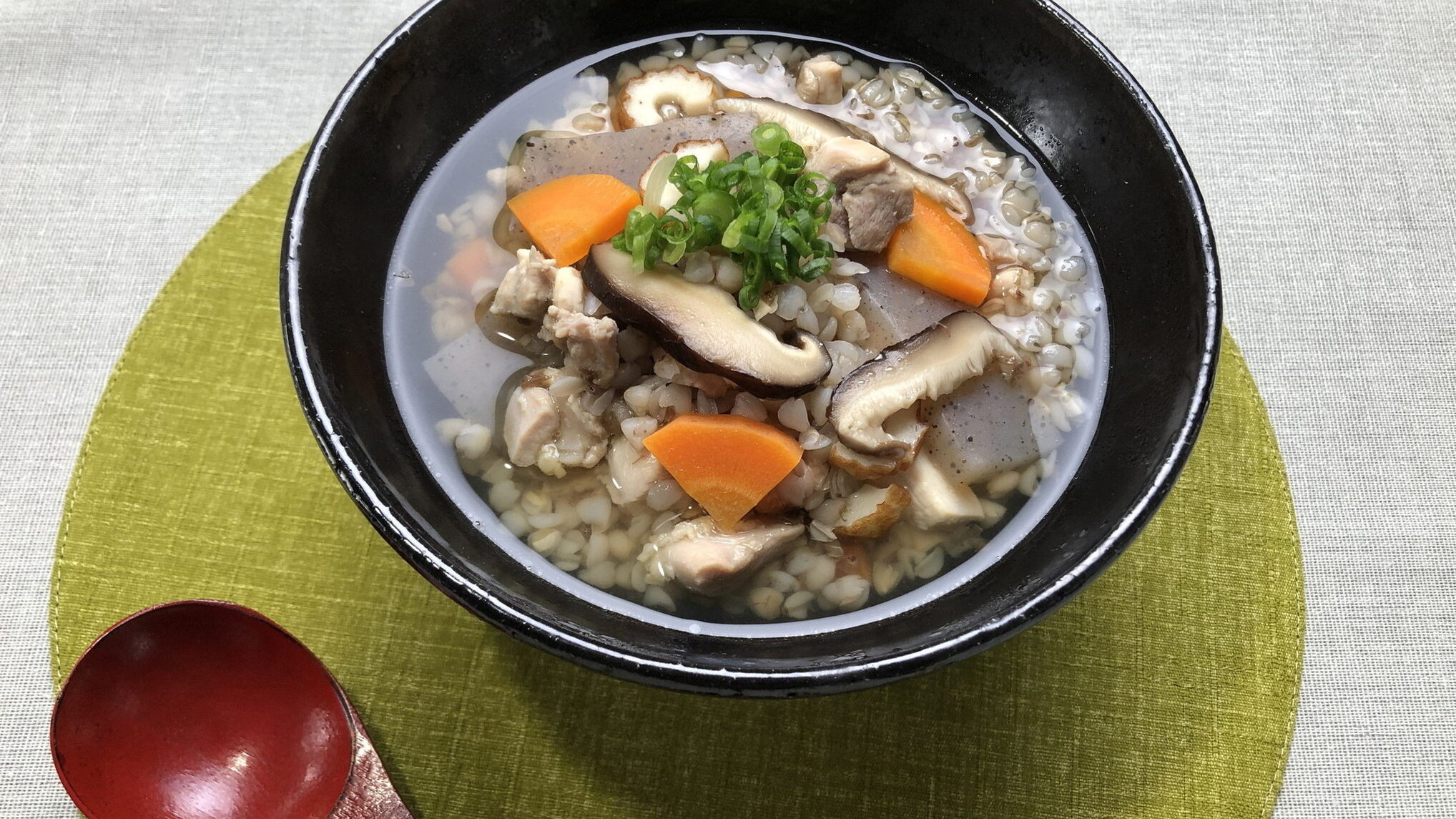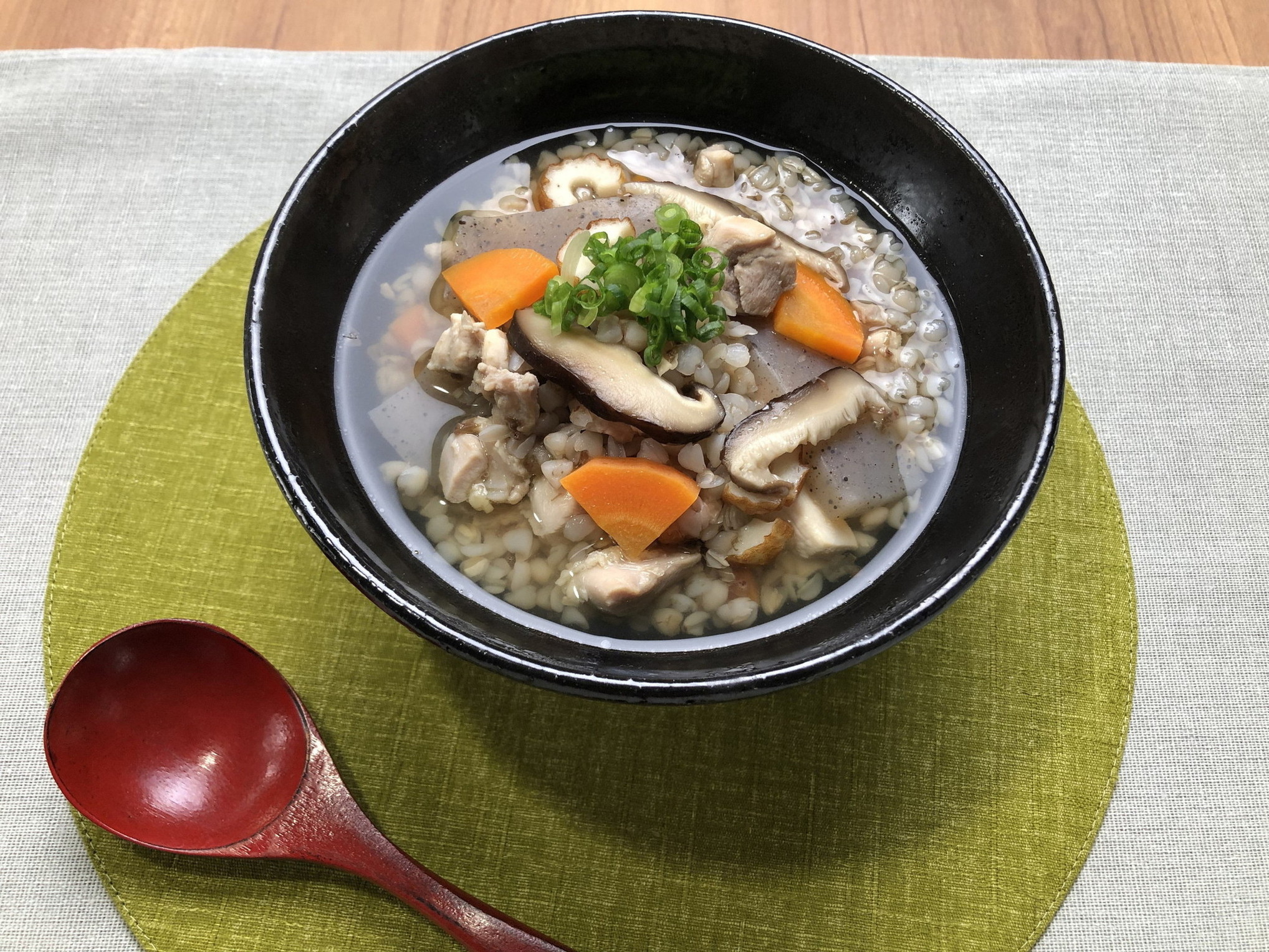
Howdy! Let’s mosey on over to Tokushima Prefecture for a hearty and wholesome dish called “Sobagome Zosui” or “Sobagome Jiru.” Now, the Iya region of Tokushima used to be pretty tough for growing rice, being all surrounded by mountains and whatnot. Legend has it that when the Heike clan, who lost the Genpei War, came to this area, they started growing buckwheat because it didn’t take as long to grow and could stand in for rice. And that’s how this sobagome (buckwheat groats) culture took root, leading to this tasty local dish. Usually, folks grind buckwheat into flour to make soba noodles, but for this zosui (rice porridge) or soup, they boil the whole buckwheat groats, hull ’em, and dry ’em. Then, these “sobagome” are simmered in broth with veggies and meat to make a super nutritious and comforting dish that’s still loved all over the prefecture.
Dish Name: Sobagome Zosui / Sobagome Jiru (Buckwheat Groats Porridge / Soup)
- Region / Location: Tokushima Prefecture (especially Iya region of Miyoshi City, and throughout the prefecture)
- Primary Area of Tradition: Iya region
- Main Ingredients: Buckwheat groats (sobagome)
How It’s Eaten / Served
Sobagome is the star of this dish, and it really puffs up when you boil it, growing to more than four times its original size! To make Sobagome Zosui, you cook chicken, konnyaku (yam cake), carrots, and dried shiitake mushrooms in a broth seasoned with soy sauce and other flavorings. Then, you add the pre-boiled sobagome to finish it off. Other common ingredients include daikon radish and chikuwa (fish sausage). The broth itself can be made with various ingredients like dried shiitake mushrooms, chicken bones, kombu (kelp), and bonito flakes, giving it a rich and savory base for the nutty buckwheat groats and other additions.
Cultural Background and Preservation
It’s said that the Heike clan, who settled in Iya, made and ate Sobagome Zosui during the New Year celebrations. Back then, the ingredients were mainly vegetables and wild mountain plants, but they would sometimes add mountain birds to make it a special feast. It’s quite unusual to eat buckwheat groats whole like this, rather than grinding them into flour, but it’s a familiar way of eating buckwheat in Tokushima. You can even easily buy sobagome at supermarkets throughout the prefecture. To help preserve and promote this local culinary tradition, Tokushima Prefecture has created a pamphlet called “Tokushima’s Local Cuisine,” which includes the history, recipes, and nutritional information of dishes like Sobagome Zosui. In recent years, freeze-dried versions of Sobagome Zosui have also become available, making it even easier for people to enjoy this healthy and historical dish.
Additional information:
- Buckwheat groats (Sobagome): The hulled kernels of buckwheat, used as a grain-like ingredient. They have a slightly nutty flavor.
- Zosui: A Japanese rice porridge made by simmering cooked rice with vegetables, meat, or fish in a broth.
- Jiru: Japanese for soup or broth. In this context, Sobagome Jiru is a soup-like version of the dish with more liquid.
- Heike clan: A powerful clan in Japan that was defeated in the Genpei War (1180-1185).
- Genpei War: A major conflict between the Taira (Heike) and Minamoto clans during the late Heian period of Japan.
- Konnyaku: A jelly-like food made from the corm of the konjac plant (yam).
- Daikon: A mild-flavored Japanese radish.
- Chikuwa: A Japanese processed food made from fish surimi that is formed into a tube shape and grilled or steamed.
- Bonito flakes (Katsuobushi): Thin shavings of dried and smoked bonito (skipjack tuna), used to make flavorful dashi.
- Freeze-dried: A method of preserving food by freezing it and then removing the ice through sublimation, resulting in a lightweight product that can be easily rehydrated.
The information about regional cuisine featured on this website (Piggy's Grandma of Japan) is summarized and adapted from the Ministry of Agriculture, Forestry and Fisheries of Japan (MAFF) website, "Our Regional Cuisines"Additional commentary is provided based on the unique experiences and perspectives of the site's editors.
The copyright for the original content regarding regional cuisine belongs to the Ministry of Agriculture, Forestry and Fisheries of Japan.
The summaries and adaptations published on this site are intended for informational purposes only. Piggy's Grandma of Japan does not guarantee the accuracy or completeness of this information. For the most accurate and complete details, please refer to the original pages on the MAFF website.


